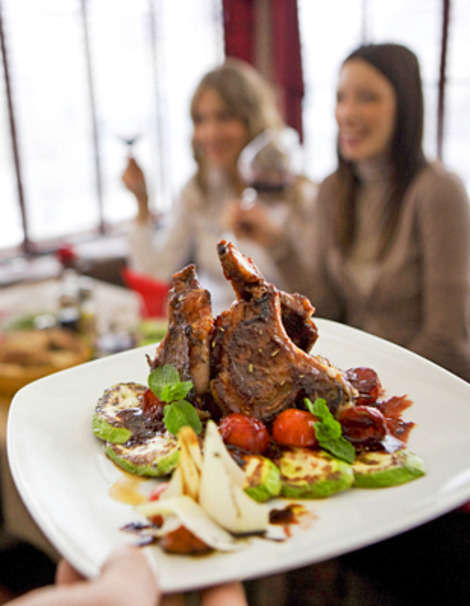The Most Fattening Restaurant Food? It's Not at McDonald's

By Susan E. Matthews, Everyday Health
While the fast food burgers and deep-fried nuggets get the bulk of the blame for our ever-expanding waistlines, new research shows that upscale, full-service restaurants can be equally destructive to our diets.
A sit-down meal at a restaurant that includes a split appetizer, an entrée, and one side can set you back an average of 1,494 calories while providing 28 grams of saturated fat and 3,512 mg of sodium, according to an estimate published in the "Journal of Nutrition Education and Behavior."
That one meal surpasses the FDA-recommended daily sodium (2,400 mg) and saturated fat (20 grams) maximums for adults, and represents three-quarters of the recommended number of daily calories (2,000). If you add a beverage and split dessert, the average meal would have 2,000-plus calories, the researchers found.
"It's no wonder so many studies show a link between eating out and obesity," said Margo Wootan, director of nutrition policy at the Center for Science in the Public Interest. "A lot of people think fast food is worse, but that's not usually the case." (FYI, a McDonald's Big Mac has a comparatively tame 550 calories, 10 grams of saturated fat, and 970 mg of sodium.)
RELATED: 9 Bad Eating Habits and How to Break Them
Researchers from Drexel University took advantage of a unique law in Philadelphia, Penn., requiring any restaurant with 15 or more locations to publicly list nutrition information. They picked 21 full-service restaurants, with prices ranging from under $10 to over $25 per entrée or appetizer, and analyzed the nutritional information of all available options. Wootan noted that non-chain restaurants of the same price level would probably have similar offerings, and nutrition results.
Appetizers might be the thing to skip if you're trying to lighten up your meal. The researchers found that the average appetizer delivered 804 calories - just as many as the average entrée.
Burgers and sandwiches accounted for the highest average calorie counts (879) in entrees, as well as higher levels of sodium and saturated fat. Other entrees were about 100 calories lighter, but at 797 calories on average, they were by no means "lite" choices. And on their own, 30 percent of the entrees and appetizers exceeded the daily recommend values for saturated fat and sodium.
RELATED: The Truth About Your Favorite Restaurant's Calorie Counts
The researchers found that entrees targeted toward children or seniors, or tagged as "healthy choice" options, had fewer calories - around 500 on average - and a little less salt and fat. Wootan noted that portion size is one of the biggest problems, so ordering small is a smart choice.
The extras that often come with a meal out could also add up quickly. Side dishes added an average 289 calories apiece, while the typical alcoholic drink had 244 calories, higher than the average non-alcoholic drink, at 161 calories. Desserts weighed in at 700-plus calories.
So what should you do with all these numbers? Quit eating out? If you're like most Americans, you eat one-third of your calories away from home, and you're not likely to go cold turkey. But here are some tips for keeping restaurant meals in check:
Any food prepared outside of your home is probably going to be less healthful than what you make yourself, so try to make eating out a treat.
Split entrees or ask the restaurant when you order to pack half of the entree to go.
Only order appetizers or desserts on special occasions.
If the menu has calorie counts - which will soon be more widely available thanks to the Affordable Care Act - pay attention to them and make lighter choices.
RELATED: Healthy Food Finds: Midday Munchies
Many public health experts, including study author Amy Auchincloss, PhD, MPH, of Drexel think that once calorie counts are required, many restaurants will realize how fattening and salty their meals are and lighten them up.
"Restaurants are realizing that just because people are interested in nutrition, they're not uninterested in taste," Wootan said.
In the meantime, order with care.
MORE ON EVERYDAYHEALTH.COM:
Dr. Sanjay Gupta: Why the Mediterranean Diet Works
Can Going Paleo for 30 Days Change Your Life?
1 in 10 Americans Serve Food Off the Floor
5 Get-Slim Supermarket Tips
This article originally appeared on EverydayHealth.com: The Most Fattening Restaurant Food? It's NOT at McDonald's
